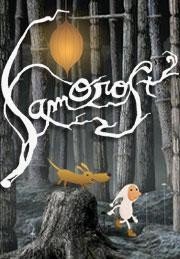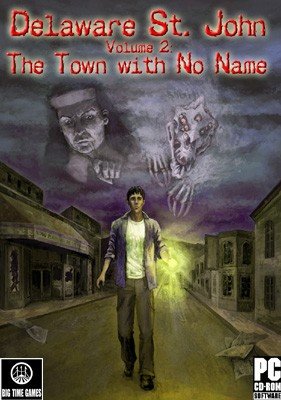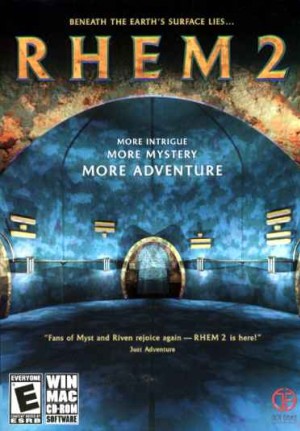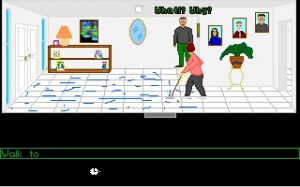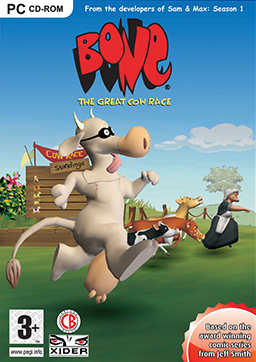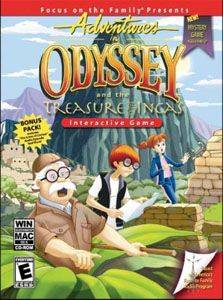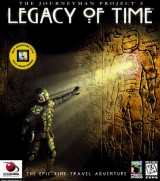Review for Jolly Rover

Game information
Adventure Gamers Awards
Yo ho, yo ho, a pirate’s… uh, a dog’s… err, a pirate dog’s life for me. Indie Australian developer Brawsome’s humorous entry into the point-and-click pirate canon, Jolly Rover, provides a light swashbuckling romp chock full of silliness, salty sea dogs, and plenty of buccaneering hijinks. We may have seen much of this before, and a few more puzzles and additional interactivity would have rounded the experience out a little better, but a variety of extras give players plenty of bonus things to do, and superb accessibility makes the game a joy to play for experienced adventurers and genre newcomers alike.
You’ll plunge into this third-person comic adventure as Gaius James Rover, an anthropomorphized foppish dachshund pup with a taste for tea. James took a wrong tack somewhere in the ocean of life and ended up as an ineffective, overly polite pirate instead of the world-renowned circus clown he was destined to be. James’ sweet naïveté isn’t a very good fit for the life of a pirate and lands him in a variety of scrapes throughout the course of the game: escaping from a pirate crew that steals his shipment of rum, landing on an island full of cannibals who aren’t what they seem to be, becoming involved in a voodoo-tangled plot between two top rival dogs, and even getting caught up in some entanglements of a more romantic nature.
Jolly Rover’s 2D cartoon art deftly complements the whimsical atmosphere. There’s nothing too spectacular in terms of graphics quality or animation, but the visuals nicely suit the game’s light-hearted nature. And there are plenty of humorous details: a silhouette of a stumbling dog on a sign posted outside The Stumble Inn; trees at a childhood home carved with silly faces and branches serving as swords; and a Jolly Roger flag with a dog instead of a human skull. The artists have also done a great job with color, pulling in some vibrant greens and blues into their tropical palette. A sunset in the islands splashes the sky with tangerine above a pale blue ocean. Against this backdrop, a lean-to with multicolored driftwood, ranging from lavenders to sea green, sets the stage for some voodoo practice. In a later trip through amber caverns, James navigates through a maze amid stalactites dotted with iridescent green stones.
The animations are functional, with some ambient motion in the backgrounds: clouds rolling, waves lapping, lamplight flickering, and of course pirate dogs quaffing rum here and there. Many of James’ actions are obscured from view, but when he does visibly carry one out, such as whipping a shiny cutlass from his pants or performing a triple flip, it’s done to great humorous effect. While travelling, James moves across the screen, down hills and through paths reminiscent of old Sierra adventure games. This could have become a burden, as there are many screens to travel through, but the developer has cleverly provided a menu option to control James’ travel speed. This serves not only to minimize the drudgery of watching your character trudge across the screen, but it’s also pretty hilarious watching James’ short little legs skedaddle at high speed.
Each of the game’s full cast of dogs, both pirate and non-pirate alike, has a distinct look: along with James himself and his long snout and pirate hat replete with jaunty red feather, there are two fat poodle chefs who appear to have been separated at birth; tall, mangy Melvin with his dreadlocks (what self-respecting pirate adventure doesn’t have a Keith Richards impersonator at this point?); the grizzled Captain Howe with gray drooping jowls; and the sinister yet urbane Governor DeSilver, among many others. The voice acting also goes a long way toward distinguishing the many different canines in the game: James is the unflappable popinjay, with a dandy voice punctuated by some yips when he’s astonished by something (which happens quite often). The salty dog pirates all have the requisite gruff pirate brogue, and Governor DeSilver is a study in easy menace.
The music is appropriately jaunty, with a full orchestra providing the soundtrack; the wind instruments -- especially the flute and the clarinet – really liven up the scores. And there is great use of background sounds. As James travels through the jungle, the sound of a waterfall gets louder as you move through each screen, and a “cha-ching” sounds off whenever you earn points in the game. The game often uses sounds amusingly as well: you don’t see James’ crew when they abandon him to his fate, but you do hear them doggy paddling away.
James survives his adventures mainly with a straightforward inventory-based approach. The puzzles in Jolly Rover are logical, and the gameplay is rather linear. You’ll rarely have to travel too far between picking something up and determining how to solve a puzzle (or vice versa, when you encounter a puzzle first, like a chest to open or a costume to make), and when you do, it’s pretty intuitive what needs to be done: keys open locks, pirates use secret knocks, and rum gets dogs drunk (which is logical if you look past the absurdity of it). If you still aren’t sure what you should be doing or how to solve a puzzle, the game provides you with a flaky sidekick parrot, Juan, who’s stored in your inventory. You’re really only working on one main puzzle at a time, so the clues available are always relevant to the task at hand. As you explore hotspots in the game, you’ll also discover Juan’s favorite food, crackers. With each cracker that you give to Juan, his clues become less cryptic. If you’d rather not have tips, you’ll want to skip giving Juan his crackers, as his “tips” pretty much spell out exactly what you need to do to accomplish a puzzle.
Besides the inventory-based puzzling, there is also a well-integrated voodoo minigame. You’ll often need to cast particular voodoo spells on appropriate objects to solve puzzles. The voodoo game involves making James recite a series of syllables associated with specific movements for individual spells. This task could have been artificially drawn out by forcing you to remember all these moves for each use, but once you’ve solved a spell the first time, it gets logged in a handy cheatsheet that helps you later in the game. Along with this minigame, there are also some mazes to navigate. Now, mazes aren’t my favorite thing in an adventure game, and I often find them to be exercises in sheer frustration, but these mazes come with compasses, turning each one into a logic exercise and not mere guesswork, madly clicking every direction in sad desperation, hoping that maybe this time, just this one more time, you’ll make it through (ahem, not that that’s ever happened to me before).
Besides the activities necessary for finishing the game, there are several more things to do in Jolly Rover: In addition to searching for inventory and crackers, you’ll also find scattered money in the form of pieces of eight. You won’t need money in the game to buy anything, but discovering them will reward you with extra goodies. You’ll also stumble upon pieces of pirate flags, which also unlock what the game calls bonus swag. Gathering enough of these items allows you to access things like concept art, theme music, and character bios.
The interface for all this puzzling and loot gathering is easy to use, as you simply left-click the dog’s paw cursor on any hotspots. Interactive objects have blue labels that turn white once you have exhausted all observations or actions. The scenes are cleanly drawn without an overwhelming amount of detail, so it’s fairly easy to see what you can click on, but if you’re still having trouble, the space bar will highlight all hotspots. It’s too bad there aren’t more things that you can interact with, and some items offer the same repetitive observation when you click on them, like the many, many barrels, empty rum bottles, and mugs. There are so many of these items that it even becomes a joke in the game. But jokes aside, more observations would have given more opportunity for humor and increased player immersion.
For those items that you actually pick up, there is an inventory bar at the bottom of the screen that pops up into full view when you mouse over it. At the top of the screen is a menu that also contains your log and loot list. The log keeps track of your rank and progress in the game, all of the swag-unlocking items you’ve gathered, and lets you view any extra goodies you’ve acquired. Your loot list shows you what medals you’ve earned along the way for certain achievements, such as collecting a certain number of coins or simply completing a certain chapter in the game, for example.
The story tying all this together certainly isn’t new. We’ve all seen humorous pirate graphic adventures before, haven’t we? But this game gets a lot right, and spends sufficient time fleshing out its characters. A drunken pirate passed out beneath some barrels in the first few scenes isn’t some throwaway, he’s a member of the pirate crew whose interest in square dancing may not necessarily match his dancing abilities. Even side characters like Captain Howe, leader of the crew that hijacks James’ ship at the opening of the game, find themselves in the middle of treacherous romantic waters as the game progresses. As for James himself, you’ll find out a bit about his past through flashbacks and drunken dream sequences involving his father, a man cut down in his prime by an unfortunate circus cannon accident.
It may not be overly original, but there are a lot of extra little details that really manage to fill out the Jolly Rover experience. You achieve points in the game for your many actions, and you can watch your rank go up (starting out as a lily-livered land lubber, passing through weevil-infested biscuit). The top of the screen provides a scrolling list of your real quests as well as funny addendums (Quest: Free strange parrot, Quest: Stay conscious, Quest: Make friends with cannibals.). All of these additional nuggets add a degree of replayability for completists. After just finishing the game, I already wanted to start over to find all the loot, uncover more extras, and even check out the director’s commentary, which you unlock once finishing the game and offers some interesting background insights.
During my six-plus hours of playing through Jolly Rover, I ultimately found no huge drawbacks to this pirate… that is, pirate dog adventure. The story of a pirate and voodoo hijinks on the high seas doesn’t break any new ground, and some may find the gameplay a little too shallow, a bit too easy. But the humor is strong, with a dash of pathos for depth: unfulfilled clown dreams, voodoo priests clamoring for your soul, cannibals that want to eat or marry you, what more can you ask for? The developer clearly put a lot of thought into user-friendly accessibility as well, and overall I found this game to be thoroughly enjoyable, and I’m hoping we see further adventures of the dashing dachshund Gaius James Rover.











